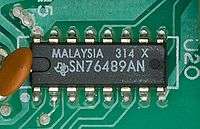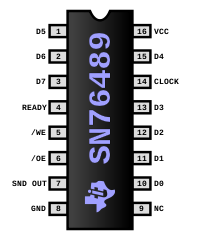Texas Instruments SN76489
The SN76489 Digital Complex Sound Generator (DCSG) is a TTL-compatible programmable sound generator chip from Texas Instruments. It contains:[1]
- 3 square wave tone generators.
- A wide range of frequencies.
- 16 different volume levels.
- 1 noise generator.
- 2 types (white noise and periodic).
- 3 different frequencies.
- 16 different volume levels.


Its main application was the generation of music and sound effects in game consoles, arcade games and home computers (such as the Texas Instruments TI-99/4A, BBC Micro, ColecoVision, and IBM PCjr), competing with the similar General Instrument AY-3-8910.
Overview
The SN76489 was originally designed to be used in the TI-99/4 computer, where it was first called the TMS9919 and later SN94624, and had a 500 kHz max clock input rate. Later, when it was sold outside of TI, it was renamed the SN76489, and a divide-by-8 was added to its clock input, increasing the max input clock rate to 4 MHz, to facilitate sharing a crystal for both NTSC colorburst and clocking the sound chip. A version of the chip without the divide-by-8 input was also sold outside of TI as the SN76494, which has a 500 kHz max clock input rate.[1]
Tone Generators: The frequency of the square waves produced by the tone generators on each channel is derived from two factors:
- The speed of the external clock.
- A value provided in a control register for that channel (called N).
Each channel's frequency is arrived at by dividing the external clock by 4 (or 32 depending on the chip variant), and then dividing the result by N.[1] Thus the overall divider range is from 4 to 4096 (or 32 to 32768). This gives a frequency range at maximum input clock rate of 122 Hz to 125 kHz (or typically 108 Hz to 111.6 kHz, with an NTSC Colorburst clock input – a range from roughly A2 (two octaves below middle A) to 5–6 times the generally accepted limits of human audio perception).
Noise Generator: The pseudorandom noise feedback is generated from an XNOR of bits 12 and 13 for feedback, with bit 13 being the noise output. The pseudorandom generator is cleared to 0s (with the feedback bit set to 1) on writes to chip register 6, the noise mode register.[1]
Product Family
There are two versions of the SN76489: the SN76489 (Narrow DIP version labeled SN76489N) and the SN76489A (Narrow DIP version labeled SN76489AN). The former was made around 1980–1982 and the latter from 1983 onward. They differ in that the output of the SN76489 is the inverse of the expected waveform (the waveform 'grows' towards 0 V from 2.5 V), while the SN76489A the waveform is not inverted.
The SN76496 seems to be totally identical to the SN76489A in terms of the outputs produced, but features an "AUDIO IN" pin (on pin 9) for integrated audio mixing.[2]
| Chip Variant | Freq (max) | Audio In |
|---|---|---|
| TMS9919 / SN94624 | 500 kHz | No |
| SN76489 / SN76489A | 4 MHz | No |
| SN76494 / SN76494A | 500 kHz | Yes |
| SN76496 / SN76496A | 4 MHz | Yes |
Clones and successors
Sega used real SN76489AN chips in their SG-1000 game console and SC-3000 computer, but used SN76489A clones in their Master System, Game Gear, and Sega Genesis game consoles. These modified sound chips were incorporated into the system's video display processor. Although basic functionality is almost identical to that of the original SN76489A sound processor, a few small differences existed: the randomness for the noise channel is generated differently, and the Game Gear's version includes an additional flag register that designates which speaker(s) each audio channel are output (left, right, or both). The periodic noise is also 16 stages long on the Sega-made clones rather than 15; this makes a significant difference for music/programs which use periodic noise, as sounds will play at 6.25% lower pitch than on the TI-made chips.[3]
Another clone is the NCR 8496, used in some models of the Tandy 1000 computer. Later Tandy 1000 machines (notably the SL, TL and RL series) integrated the SN76496's functionality into the PSSJ ASIC.
Usage
Arcade games
- These games shared a common board design by Tehkan that used three of the functionally identical SN76496.
- Baluba-Louk No Densetsu
- Senjyo
- Star Force
- These games shared a common board design by Universal Entertainment Corporation:
- Lady Bug (used 2)
- Mr. Do! (used 2 of a functionally-identical part labeled U8106)
- Mr. Do's Castle (used 4)
- Mr. Do's Wild Ride (used 4)
- Do! Run Run (used 4)
- From Konami:
- Road Fighter
- Time Pilot '84 – uses the functionally identical SN76496
- From Sega:
- Block Gal
- Congo Bongo
- Bank Panic
- Sega Mega-Tech
- Sega System 1
- Sega System 2
- Sega System E was based on the Master System and used the clone chip in its VDP.
Home hardware
- ALF's Music Card MC1 – Apple II add-on card, uses three chips for a total of nine voices plus noise
- BBC Master
- BBC Micro
- Coleco Adam
- ColecoVision
- CreatiVision
- Geneve 9640
- IBM PCjr
- Memotech MTX
- Neo Geo Pocket
- Neo Geo Pocket Color
- Game Gear – used a clone integrated into its VDP that has an additional speaker-output register for simple stereo support.
- Sega Genesis
- Master System – used the clone integrated into its VDP.
- Mega-Tech
- Pico
- SG-1000 – uses the SN76489AN
- Sharp MZ-800 – uses the SN76489AN
- Sord M5
- Tandy 1000 – early systems used SN76496 or NCR 8496, later systems integrated into PSSJ ASIC
- SN76489 ISA Soundboard – Hobbyist Soundcard for IBM XT/PC
- Lo-Tech Tandy Soundboard – Prototype Soundcard for IBM XT/PC
- Texas Instruments TI-99/4A – uses the original TMS9919
- Tomy Tutor
See also
References
- Engineering staff of Texas Instruments Semiconductor Group. "SN 76489 AN" (PDF).
-
"SN76494, SN76494A, SN76496, SN76496A programmable tone/noise generator" (PDF). Texas Instruments. 1984, 1989. Check date values in:
|year=(help) - Maxim (April 27, 2005). "SN76489 notes". SMS Power!. Archived from the original on May 17, 2006.
External links
| Wikimedia Commons has media related to SN76489. |